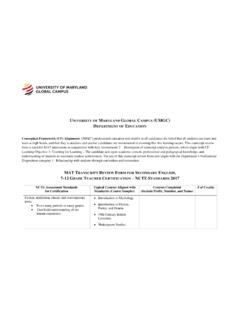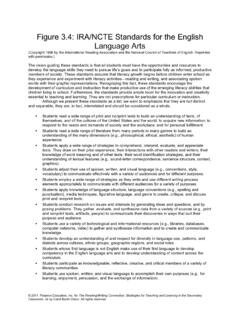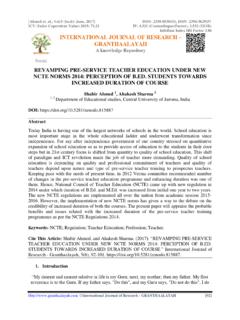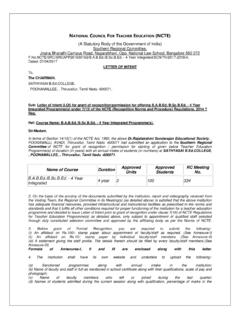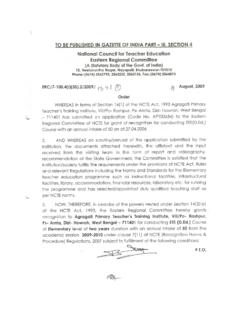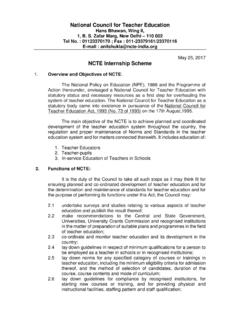Transcription of edTPA Questions and Answers about NCATE …
1 NCATE and SCALE 1/7/2013 Page 1 edTPA Questions and Answers about NCATE accreditation october 22, 2012 This document was prepared in response to requests for clarity about the alignment of NCATE standards and edTPA . NCATE accredited institutions implementing edTPA as a culminating teacher performance measure for candidates are interested in examining the impact of edTPA adoption and their accreditation processes. The Questions posed and Answers provided below reflect NCATE standards and processes. The alignment of edTPA and the new CAEP standards and processes will be determined after the new standards are released. 1. How does the edTPA align with NCATE (unit) standards ? In using the terms align and alignment, NCATE means that the goals and tasks of edTPA and the expectations in the NCATE standards are comparable.
2 Institutions using edTPA to provide evidence of candidate performance can be assured that some aspects of the performance assessment provide the type of evidence that NCATE seeks in determining whether or not a unit s teacher candidates have the knowledge, skills, and dispositions that are outlined in its standards . On a broad scale, the contents of edTPA have points of alignment with four of the six NCATE standards , specifically Standard 1: Candidate Knowledge, Skills and Professional Dispositions Standard 2: Unit Assessment System Standard 3: Field Experiences and Clinical Practice Standard 4: Diversity Standard 5 related to unit faculty qualifications and standard 6 related to unit resources and governance are not measured by the edTPA , which is a teacher performance assessment.
3 Although there are many points of alignment with each of the four standards listed above, some expectations outlined in these four NCATE standards are not directly addressed by edTPA . The paragraphs below describe the specific ways in which edTPA and the NCATE standards are aligned. NCATE s Standard 1: Candidate Knowledge, Skills, and Professional Dispositions is its most complex and multi-faceted standard. Its supporting elements include content (1a), pedagogical content (1b), professional and pedagogical knowledge and skills (1c) as well as student learning (1d) and professional dispositions (1g). edTPA s alignment with NCATE s Standard 1 is most evident in the tasks and rubrics (1, 81 and 9) related to planning for subject matter understandings, deepening student learning and subject specific pedagogy.
4 Throughout edTPA tasks and rubrics there is a strong emphasis on student learning in planning, adapting instruction, and then assessing student learning to make further instructional adaptations and decisions. The student learning expectation in NCATE s standard 1 (element d) is considered to be the one of the most challenging aspects of the standards for which to provide evidence. For each of the student learning expectations outlined below from the NCATE rubrics, edTPA provides the evidence in planning, teaching and assessment tasks along with the rubrics used to assess candidate performance. 1 Rubric numbers refer to the Secondary Mathematics edTPA handbook.
5 NCATE and SCALE 1/7/2013 Page 2 1. Teacher candidates focus on student learning. (rubrics 1, 7, 8, 9, 11 through 15) 2. Teacher candidates a. assess and analyze student learning, (rubrics 5, 8, 11, 12, 13 and 14) b. make appropriate adjustments to instruction, and (rubrics 8, 10, 15) c. monitor student progress. (rubrics 5, 8, 11, 12 and 14) 3. They are able to develop and implement meaningful learning experiences for students based on their developmental levels and prior experience.(rubrics 2 and 7) Other elements of Standard 1 related to Other School Professionals, dispositions, and content knowledge, for example, are still an expectation for the unit. The summary table at the end of this section highlights the elements of each NCATE standard and the points of alignment with edTPA .
6 There are many elements included in NCATE s Standard 2: Assessment System and Unit Evaluation. edTPA s alignment with NCATE s standard 2 is most evident in two expectations for this standard: 1. The unit s system includes comprehensive and integrated assessment and evaluation measures to monitor candidate performance and manage and improve the unit s operations and programs. edTPA is a comprehensive assessment measure that monitors candidate performance at the conclusion of a candidate s program of study. 2. The unit has taken effective steps to eliminate bias in assessments and is working to establish the fairness, accuracy, and consistency of its assessment procedures and unit operations. edTPA is a performance-based assessment with established reliability and validity.
7 Fairness, accuracy, and consistency of its procedures are designed to address the technical standards established by AERA, NCME, and APA. The remaining elements of NCATE s standard 2 are related to multiple measures at multiple points in a candidate s preparation. Programs are structured to systematically collect, analyze, aggregate and disaggregate, data and to improve program and unit operations. These are expectations that the unit must ensure, irrespective of its adoption of edTPA as a culminating performance assessment measure. There are three distinct elements that comprise the heart of NCATE s Standard 3: Field Experiences and Clinical Practice. However, the edTPA s alignment with NCATE s standard 3 is most evident in the third element that is focused on Candidates Development and Demonstration of the Knowledge, Skills, and Professional Dispositions to Help All Students Learn.
8 At three points in its descriptive statements about what is required to meet this element of Standard 3 at an acceptable level, the rubric states that: 1. Multiple assessment strategies are used to evaluate candidates performance and impact on student learning, and 2. Candidates and clinical faculty systematically examine results related to P 12 learning. They begin a process of continuous assessment, reflection, and action directed at supporting P 12 student learning. (Rubrics 5, 10-15) NCATE and SCALE 1/7/2013 Page 3 3. Candidates collect data on student learning, analyze them, reflect on their work, and develop strategies for improving learning.(Rubrics 5, 11, 12, 13, 14, 15) edTPA requires that candidates complete a number of tasks that span the cycle of instruction from planning, enacting and assessing, and analyzing/reflecting upon student learning.
9 These multiple strategies include a thorough analysis of a number of student work samples and a statement about how instruction will be adapted to the students learning needs. With the remaining elements of the standard, it is the unit s responsibility to ensure the quality and diversity of the field placements as well as the collaboration with school partners in designing, implementing and evaluating those field experiences and clinical practice expectations. In NCATE s Standard 4: Diversity there are a number of elements to ensure that candidates have the opportunity to work with other diverse candidates, faculty and p-12 students. However, the first element of the standard relates to the Design, Implementation, and Evaluation of Curriculum and Experiences, is the element where edTPA s tasks and rubrics are strongly aligned with NCATE s expectations.
10 At five points in its descriptive statements about what is required to meet this element of Standard 4 at an acceptable level, the rubric states that: 1. Candidates connect lessons, instruction, or services to students experiences and cultures. Three of the edTPA planning rubrics (2, 3 and 4)) assess the degree to which candidates are using knowledge of students to inform their teaching (including varied learning needs, personal/cultural/community assets, and language development). One rubric within the instruction task (rubric 7) examines the extent to which a candidate engages students in learning by building upon prior academic learning as well as lived experiences (personal/cultural/community assets). 2. Candidates incorporate multiple perspectives in the subject matter being taught or services being provided.
